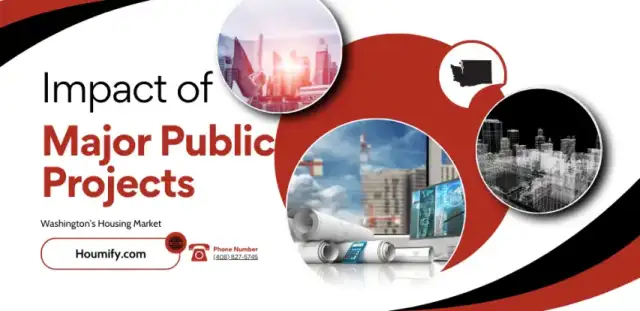Impact of Major Public Projects on Washington’s Housing Market
How Major Public Projects Are Transforming Washington’s Housing Market
Major public projects are powerful catalysts for change, particularly in a state like Washington where rapid growth has placed increasing pressure on housing. From infrastructure improvements to large-scale urban developments, these projects not only enhance connectivity and livability but also significantly impact the real estate market. For homeowners, developers, and investors, understanding the Impact of Major Public Projects on Washington’s Housing Market is essential for making informed decisions.
Washington’s housing market has experienced steady appreciation over the years, fueled in part by transformative public projects. Examples include Sound Transit’s light rail expansion, the North Spokane Corridor, and the Alaskan Way Viaduct Replacement. These initiatives have improved access to previously overlooked areas, raised property values, and reshaped housing demand patterns.
This article explores how Washington’s major public projects are driving changes in the housing market. From uncovering the dynamics of search intent to breaking down actionable insights, we’ll provide you with the information you need to navigate this evolving market landscape.

Why People Search About Public Projects and Housing
Understanding search intent behind the topic of public projects and their impact on housing markets is vital. Individuals and businesses alike are seeking answers to pressing questions about property values, market trends, and opportunities tied to major infrastructure upgrades.
Common Search Questions and Needs
- What public projects are currently underway in Washington?
- How do public projects like light rail expansions impact housing demand?
- Which areas in Washington are experiencing rising property values due to infrastructure improvements?
- What are the long-term effects of urban revitalization on housing prices?
- How can investors identify real estate opportunities tied to public projects?
Types of Search Intent Related to the Topic
- Informational Intent: Users want to understand the correlation between public projects and real estate market trends.
- Navigational Intent: Searchers may look for specific projects, such as the Sound Transit Link Light Rail or North Spokane Corridor.
- Transactional Intent: Investors are looking to identify neighborhoods with appreciating property values due to public infrastructure improvements.
- Commercial Intent: Developers compare public project impacts to evaluate new housing or mixed-use developments.
How Public Projects Influence Washington’s Housing Market
Public projects—whether transportation upgrades, urban redevelopment initiatives, or new infrastructure—play a pivotal role in shaping Washington’s housing market. Here are the most significant ways these projects affect real estate:
1. Enhanced Accessibility Drives Demand
When a public project improves transportation or accessibility, nearby areas often experience a surge in housing demand.
- Light Rail Expansion: Projects like the Sound Transit Link Light Rail have made suburban areas like Lynnwood, Federal Way, and Redmond more accessible to Seattle commuters, driving up property values.
- Highway Upgrades: The North Spokane Corridor is expected to shorten commute times and make northern Spokane a more attractive option for families and businesses.
2. Neighborhood Revitalization and Gentrification
Urban redevelopment projects often breathe new life into older neighborhoods, increasing demand and raising property values.
- The Waterfront Seattle Project transformed the downtown waterfront into a vibrant, pedestrian-friendly space, boosting nearby condo values.
- Redevelopment of Seattle’s Pioneer Square has attracted new businesses and residents, driving property appreciation while also raising concerns about affordability and gentrification.
3. Improved Livability Attracts New Residents
Public projects often include amenities that enhance quality of life, such as parks, bike lanes, and pedestrian pathways. These improvements make neighborhoods more desirable for homebuyers and renters.
- The Alaskan Way Viaduct Replacement freed up space for parks and recreational areas, significantly improving the livability of nearby neighborhoods.
- Bellevue’s Grand Connection, which includes pedestrian-friendly pathways, is expected to increase property values in surrounding areas.
4. Increased Construction Activity
Major public projects often spark a wave of new construction, from residential developments to mixed-use projects. This can alleviate housing shortages in high-demand areas.
- The Northgate Link Light Rail spurred a surge in new apartments and townhomes near the station, providing much-needed housing inventory.
- Tacoma’s downtown revitalization efforts have encouraged developers to build high-density housing, meeting the needs of a growing population.
Case Studies: Public Projects Transforming Washington
Washington State has several high-profile public projects that are reshaping local housing markets. Here are some notable examples:
Sound Transit Link Light Rail Expansion
- Impact: Properties within walking distance of light rail stations have seen a 10-15% increase in value, according to Redfin.
- Key Areas: Ballard, Lynnwood, Redmond, and Federal Way.
- Long-Term Potential: As the light rail expands, additional neighborhoods are likely to benefit, making this a long-term driver of housing appreciation.
North Spokane Corridor
- Impact: This highway project is expected to reduce traffic congestion and improve connectivity between Spokane and its northern suburbs.
- Key Areas: Property values in neighborhoods like Mead and Shiloh Hills are expected to rise as accessibility improves.
Alaskan Way Viaduct Replacement and Waterfront Revitalization
- Impact: Removing the viaduct has transformed Seattle’s waterfront, increasing demand for nearby condos and luxury properties.
- Key Areas: Belltown, Pioneer Square, and West Edge.

Opportunities for Real Estate Investors
For investors, major public projects present unique real estate investing opportunities to capitalize on housing market trends. Here’s how to get started:
1. Invest Early in Emerging Areas
- Focus on neighborhoods near planned infrastructure projects or transit hubs. Properties purchased before project completion often see the greatest appreciation.
2. Research Zoning Changes
- Public projects often lead to zoning updates that allow for higher-density developments. Investors can benefit from these changes by building or acquiring multi-family properties.
3. Diversify Investment Types
- Consider both residential and commercial properties near public projects, as improved accessibility can boost demand for both.
Practical Tips for Buyers and Sellers
For Buyers
- Prioritize Accessibility: Look for properties near public projects that improve transportation or add amenities.
- Monitor Project Timelines: Properties tend to appreciate as projects near completion, so timing your purchase is key.
For Sellers
- Highlight Project Benefits: When marketing your property, emphasize its proximity to public projects and the lifestyle benefits they offer.
- Wait for Completion: If possible, hold off on selling until nearby projects are complete to maximize your property’s value.
The Future of Washington’s Housing Market
The Impact of Major Public Projects on Washington’s Housing Market is undeniable. From transportation upgrades to urban redevelopment, these initiatives are driving significant changes in property values, demand, and livability.
Whether you’re a homebuyer, investor, or real estate professional, understanding these dynamics can help you make informed decisions and seize opportunities in Washington’s competitive housing market. By staying ahead of public project timelines and market trends, you can position yourself for success in this evolving landscape.
What do you think about Washington’s major public projects and their impact on housing? Share your thoughts in the comments below! If you found this article helpful, consider sharing it on social media to spark further discussion.